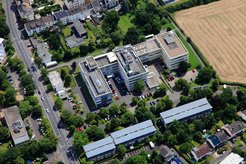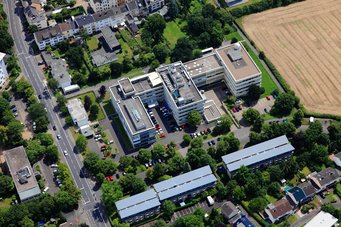50 years of Max Planck Institute for Radio Astronomy
German Research Institute was founded in 1966 in Bonn
The establishment of the Max Planck Institute for Radio Astronomy in Bonn, Germany, was closely connected with the construction of the 100-m radio telescope near Effelsberg, a small village in the Eifel mountains which is part of Bad Münstereifel, a town approximately 40 km southwest of Bonn. After the completion of the site selection process, Prof. Otto Hachenberg from Bonn University became the founding director of the new institute of the Max Planck Society which started operations in September 1966. The institute grew out of the Bonn University Astronomy Department to become one of the leading institutes for radio astronomy in the world.

The Effelsberg 100-m radio telescope, seen from the visitors’ pavilion. A zig-zag path leads from the pavilion to a viewing spot directly in front of the big dish. Please be aware that electronic devices, in particular mobile phones should be switched off (or in flight mode) in the vicinity of the telescope since radio frequency interference (RFI) has a significant impact on the sensitive observations with the telescope.
An application to build a large-scale radio telescope of 100-m diameter in Germany was submitted to the Volkswagen Foundation. Under the condition that the operation of the telescope would be entrusted to a specific different organization the foundation agreed on financing the construction of the telescope. Thus the Max Planck Society (MPG) running a number of institutes for fundamental research in Germany founded a new institute, the Max Planck Institute for Radio Astronomy (MPIfR), in order to operate the 100-m radio telescope.
First an appropriate site for the new radio telescope had to be established. A valley almost at the border between the two states of Northrhine Westfalia and Rhineland Palatinate near Effelsberg (Bad Münstereifel) was appropriate: the site had to be in a valley protected against radio frequency interference (RFI), in the 1960s mainly caused by radar from nearby air bases. Nevertheless it should enable as much access to the sky as possible. The Effelsberg valley is open in southern direction where sources culminate and reach their highest position in the sky. Thus several important regions in the sky including the centre of our Galaxy, the Milky Way, are accessible for observations.
The 100-m radio telescope (Fig. 1) was built between 1967 and 1971 and fully opened up for astronomical observations in 1972. Over the years virtually all the observing methods of radio astronomy were implemented in Effelsberg.
Later on, the MPIfR has been additionally involved in higher-frequency research in the mm, sub-mm and even infrared wavelength regime. Radio telescopes commissioned by the institute include the 30-m telescope in Spain, the 10-m Heinrich Hertz telescope in Arizona/USA and since 2005 the 12-m Atacama Pathfinder Experiment (APEX) which is operated by MPIfR together with ESO and the Swedish Onsala observatory. The first German station of the International LOFAR Telescope (Low Frequency Array) was built in 2007 at the Effelsberg observatory site.
After the foundation of the Max Planck Institute for Radio Astronomy in 1966 labs and offices were first subdivided between different buildings in the city of Bonn. In 1973 a new building was completed in Bonn-Endenich, including space for both, MPIfR and the astronomy institutes of Bonn University. The institute building was considerably enlarged in the years 1983 and 2002 (Fig. 2).
At present there are three different research departments at MPIfR:
- Fundamental Physics in Radio Astronomy (Michael Kramer),
- Millimeter and Submillimeter Astronomy (Karl M. Menten)
- Radio Astronomy/VLBI (J. Anton Zensus).

They are complemented by a number of technical departments, on Digital Signal Processing, Electronics, Infrared Technology, Submillimeter Technology and VLBI Technology.
The 100-m radio telescope remains the ‘work horse’ of the institute. The Effelsberg radio telescope celebrated its 40th anniversary of operations in May 2011 and is still going strong. Observations with the telescope have resulted in thousands of publications. It served several generations of radio astronomers and gave hundreds of young students the opportunity to complete doctoral degrees. Since 2002 a doctoral school, the “International Max Planck Research School for Astronomy and Astrophysics” (IMPRS) has been operated by the institute in collaboration with the two universities at Bonn and Cologne. The 100-m radio telescope has been continuously upgraded, is in an excellent condition and can look to a further period as an important research instrument, paving the way for radio astronomy in the future.

